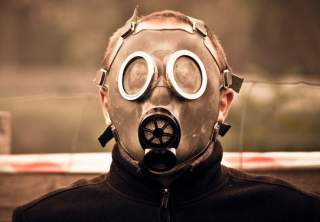Inside Assad’s Shadowy Chemical Weapons Factory
By 1992, the Department of Defense considered Syria a regional leader in chemical weapons capabilities thanks in no small part to CERS.
Syria’s Scientific Studies and Research Center (CERS) may sound benign in name, but the recently sanctioned organization is almost single-handedly responsible for developing the country’s chemical and unconventional weapons programs.
The Treasury Department’s Office of Foreign Assets Control sanctioned 271 employees of CERS Monday, more than doubling the number of sanctioned persons and entities under Syria-related executive orders. The designations follow the Syrian government’s sarin gas attack on civilians on the town of Khan Sheikhoun on April 4, which left at least 72 people dead.
(This first appeared on The Daily Caller News Foundation’s site here.)
“These sweeping sanctions target the scientific support center for Syrian dictator Bashar al-Assad’s horrific chemical weapons attack on innocent civilian men, women, and children,” said Treasury Secretary Steven Mnuchin in a statement Monday. “The United States is sending a strong message with this action that we will hold the entire Assad regime accountable for these blatant human rights violations in order to deter the spread of these types of barbaric chemical weapons.”
CERS is primarily responsible for advancing Syria’s unconventional weapons programs, including its chemical weapons stockpiles and nuclear research. It was established in 1971 by Assad’s father, Hafez, as a civilian agency, but its focus quickly turned to weapons development by 1973.
Syria’s arsenal drastically expanded over the next several decades, with the help nefarious actors like Iran and North Korea, and even some not-so-nefarious ones, like the former West Germany and France.
By 1992, the Department of Defense considered Syria a regional leader in chemical weapons capabilities thanks in no small part to CERS.
Many of Syria’s top scientists are posted at the center’s shadowy Jamraya research center, a heavily militarized location built with the help of the Soviet Union in the 1980s. Jamraya’s employees are reportedly banned from speaking to foreign agencies and persons, particularly while the country is engaged in warfare, according to the BBC. The location is heavily guarded, as it serves as base of operations for the 105th and 4th Presidential Guards brigades, the latter of which is headed by Assad’s own brother, Maher. Many of the military assets at the location are believed to be buried underground.
The center caught the attention of the Bush administration in 2005 and became subject to an executive order against proliferators of weapons of mass destruction. Treasury froze the assets of SRCC subsidiaries in 2007 for proliferating ballistic missiles, chemical and biological weapons.
Israeli forces struck Jamraya in January and May 2013. Israeli officials had long suspected the SRCC of arming the Hezbollah and Hamas terrorist groups.
The April attack was not the SRCC’s first involvement in chemical weapons strikes against civilians. A French intelligence assessment determined that the SRCC’s “Branch 450” — comprised of Assad loyalists from the Alawite sect — were responsible for filling bombs with chemical agents that killed 1,429 people in August 2013.
The center’s fingerprints were also on the more recent Khan Sheikhoun attack April 4. A recently declassified French intelligence report noted the sarin used in the attack contained hexamine, an additive unique to Syrian stockpiles that improves the effectiveness of the chemical agent. CERS supposedly pioneered the addition of hexamine to sarin.
President Barack Obama warned Assad in 2012 that the use of chemical weapons would cross a “red line” and force U.S. intervention. Obama reneged on the threat after the 2013 sarin attack. Instead, the international community forced Assad to give up his chemical weapons stash and acquiesce to the chemical weapons convention, or so they thought.
The French intelligence report noted there were several major discrepancies in not only the tallying of Assad’s chemical weapons, but also the follow through of inspectors from the Organization for the Prohibition of Chemical Weapons (OPCW).
“France assesses that major doubts remain as to the accuracy, exhaustiveness and sincerity of the decommissioning of Syria’s chemical weapons arsenal,” said the report. “In particular, France assesses that Syria has maintained a capacity to produce or stock sarin, despite its commitment to destroy all stocks and capacities. Lastly, France assesses that Syria has not declared tactical munitions (grenades and rockets) such as those repeatedly used since 2013.”
Former Secretary of State John Kerry hailed the alleged completion of the agreement in 2014, claiming that “100 percent” of chemical weapons were out of Syria. The Khan Sheikhoun attack proved that to be false.
It is now clear that Assad hid large amounts of the chemical components required to make sarin, specifically 20 tons of methylphosphonyl difluoride (DF), which the regime reported was “used in tests or lost,” according to the report. French intelligence also claimed to have observed Syria attempting to acquire “dozens of tons” of isopropanol, another key sarin ingredient, since 2014.
The report does not clarify whether CERS was responsible for mixing new batches of sarin after Assad signed the agreement, or if the stockpiles already existed. That said, the presence of hexamine at the attack site means the center was likely involved at some point throughout the process.
Content created by The Daily Caller News Foundation is available without charge to any eligible news publisher that can provide a large audience. For licensing opportunities of our original content, please contact [email protected].
Image Credit: Creative Commons.

